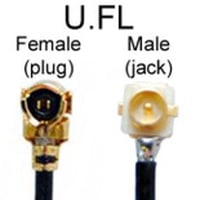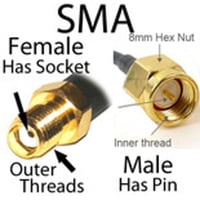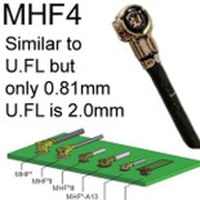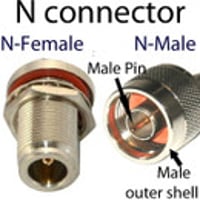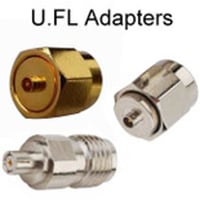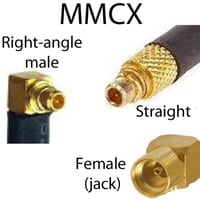MHF4 Cables & Adapters
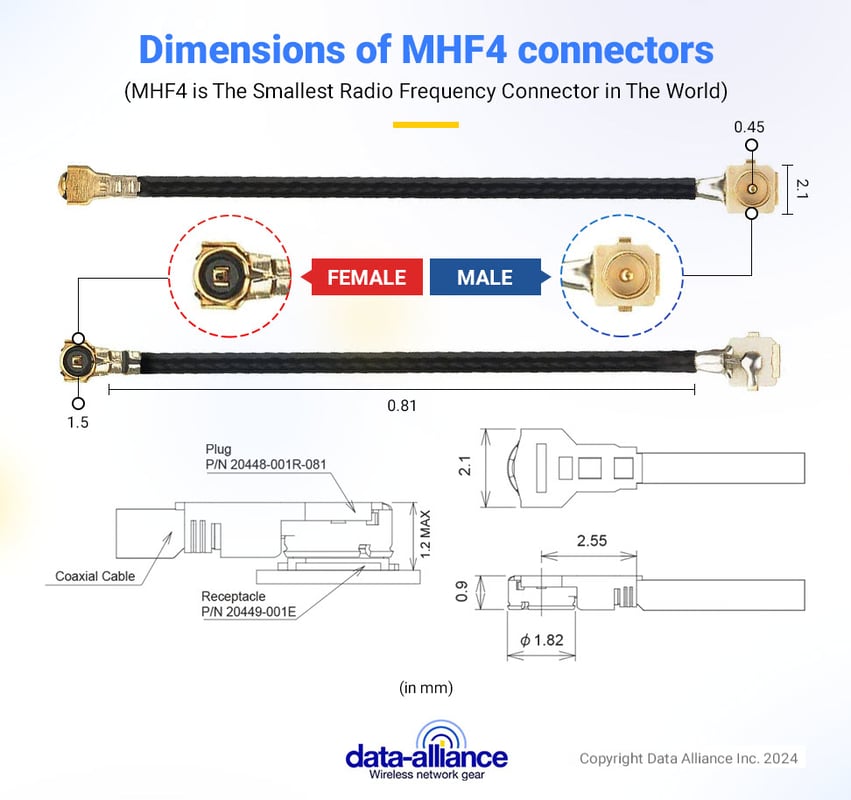
MHF4 Cables: Attributes & Applications
MHF4 is a micro connector / micro RF coax connector with the key attributes of having the ability to maintain high-frequency coaxial connection with very small sized connectors, both male and female.
MHF4 cables can be made with only two coax types: 0.81mm or 1.13mm (in diameter): Both are very thin and flexible. Naturally, 1.13mm is preferred as long as the space inside the casing can accommodate the slightly larger bend radius of 1.13mm coaxial cable.

The MHF4 connector has one central pin and an outer socket that corresponds to a female connector. While mated, the connector’s height is only 1.2 mm. The cable and connector are joined using an efficient solderless crimping process.
- MHF4 cables can only be made with the very thin coaxes such as 1.13 and 1.32.
- MHF4 is NOT compatible with LMR-100 and RG178.
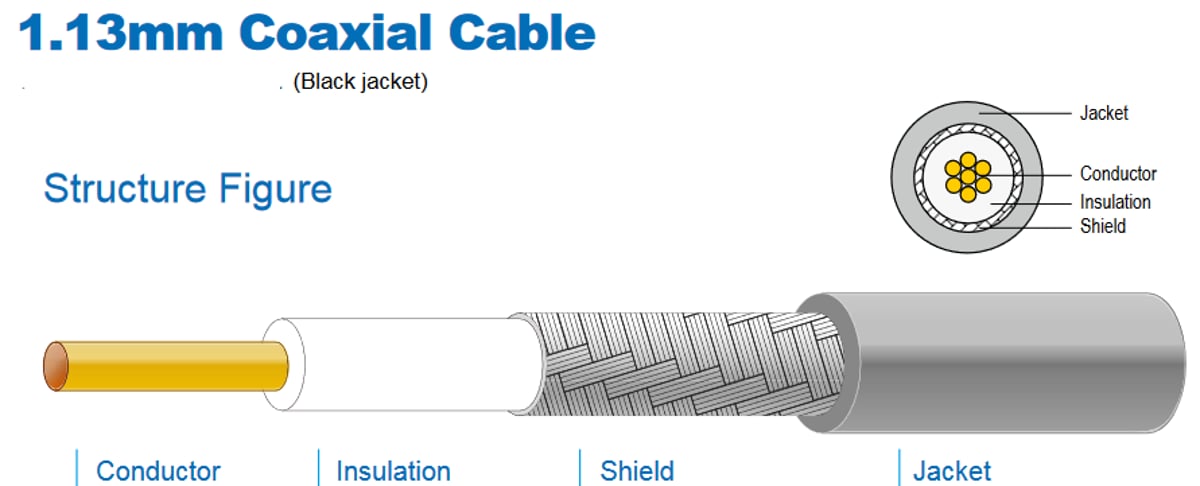 MHF4 Connectors' Gender is confusing because a MHF4 jack, such as you would find on a miniPCI male wireless card or board is the male MHF4 connector. So MHF4 gender is an exception to the rule for most other RF connector types, for which "jack" is synonymous with "female connector."
MHF4 Connectors' Gender is confusing because a MHF4 jack, such as you would find on a miniPCI male wireless card or board is the male MHF4 connector. So MHF4 gender is an exception to the rule for most other RF connector types, for which "jack" is synonymous with "female connector."
Coax Cable for MHF4:
The very small size of MHF4 connectors requires that we make MHF4 cables with 1.13mm coax only. We do not supply MHF4 cables with 1.37mm coax because it’s very expensive and production time would be much longer. Thus, we strongly recommend against using MHF4 connectors with 1.37mm cable. LMR-100 is much too large in diameter for MHF4 connectors.
MHF4 connectors and cables are used in high-frequency transmissions devices where physical space is a serious constraint. MHF4 has a working frequency of up to 6GHz.
How to Prevent the MHF4 Connector From Detaching from the Cable
The MHF4 connector is commonly used in small-form-factor applications such as internal wireless cards in laptops. If you're finding that the MHF4 connector is easily detaching from the cable, it could be due to a few reasons. Here's how you can address this problem:
Inspect the Connector and Cable:
- Check for visible damage or deformities on the connector or the cable. If the connector is damaged, it might not clip securely to the mating part.
- Ensure the cable is properly crimped to the connector.
Proper Insertion:
- Make sure you're connecting the MHF4 plug correctly. It should snap into place when properly mated.
- The plug should be pushed straight on and pulled straight off to avoid bending or damaging the connector.
Reinforce the Connection:
- If the connection is crucial and you want to add an extra layer of security, consider using a small dab of non-conductive adhesive or glue around the edge of the connector (not on the contacts). However, this will make future disconnections more challenging.
- Avoid using any adhesive that might migrate into the connector as this will degrade the signal quality and could cause other issues.
Cable Strain Relief:
- Ensure that the cable isn't being pulled or tugged, as this can cause the connector to detach. Provide strain relief for the cable so that any forces on the cable don't directly translate to the connector.
- Use cable ties or adhesive cable mounts to keep cables in place and reduce tension on the connectors.
Check the Mating Connector:
- The problem might not be with the MHF4 connector on the cable but with the mating part it's being connected to. Inspect it for damage, wear, or debris. Clean it if necessary and ensure that it holds the MHF4 connector securely.
Replacement:
- If the connector keeps detaching and you've ruled out external forces or improper connection, it might be best to replace either the cable with the MHF4 connector or the mating part, or both. Over time and with frequent connections and disconnections, connectors can wear out.
Environment Factors:
- Ensure that the environment isn't causing the problem. Excessive vibration, for instance, could cause the connector to become loose. If this is the case, you might need to find a way to dampen the vibration or secure the connection more effectively.
Consult Manufacturer or Expert:
- If you're unsure or if the problem persists, it might be best to consult with the manufacturer or seek expert advice. There might be known issues or solutions that you're not aware of.
Remember, when working with connectors, especially those used in RF applications, it's essential to be gentle and avoid forceful actions that might damage the delicate components.

Because of its support for high frequencies, the MHF4 is ideal for use in such devices as:
- Bluetooth antennas
- Wi-Fi antennas on routers.
- LTE and GSM antennas
- GPS communication devices.
- Wireless microphone antennas.
- Laptop Wi-Fi mini-PCI cards.
MHF4 can be used on a wide variety of devices that rely on a wireless interface. Its small size and efficiency make it reliable and rather inexpensive. There is only one issue: The connectors are very easily damaged by repeated connecting and disconnecting: They are not designed for multiple mates. The maximum number of times that the female connector can be connected to the male jack, is 30 mates, after which the connectors must be replaced.
MHF4 Jack on PCB
The MHF4 jack is designed as an alternative to the Murata HSC connector due to its size and low profile. The male connectors are typically mounted on the surface and then directly soldered onto the printed circuit board. They come with their characteristic 50 Ohms of impedance. The cable assemblies can transmit signals to connect WLAN antenna, WLAN modular, GPS antenna and GPS modular, GSM antennas and GSM modular.
Internet of Things and MHF4 Connectors
MHF4 and U.FL connectors are the connectors of choice for Internet of Things (IOT) devices. Their push on mating style and low profiles make them ideal for IOT since they do not require any torque wrenches. Moreover, they can perform up to 6GHz, and provide you with a choice of antenna options from pigtail, chip antenna, and wire antenna that you can use to connect with the externally mounted antenna. External mounting is the norm in the instance of a metallic enclosure casing, given that such casing is a great impediment to RF signals.

